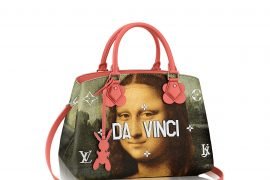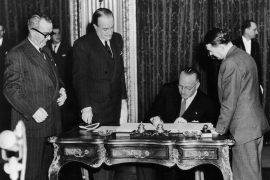[dropcap letter=”B”]
ased on Jean Poiret’s comedy, La Cage aux Folles is a musical by Harvey Fierstein and Jerry Herman that premiered on Broadway in 1983 and was staged until 1987, with box office success and recognition at the Tony Awards. Re-released in 2004, it won another award, in this occasion the “Best revival” category. The synopsis is simple, which will allow the entanglements to multiply and the plot to take off. Albin and Georges are a gay couple that runs La cage aux folles, cabaret at the Côte d’Azur, where they schedule dance shows.
 There reigns an atmosphere of moral openness that can hardly be tolerated by the future father-in-law of Jean-Michel (biological son of Georges). He, a politician of the conservative party, defends a traditional family model and prepares to visit them together with his wife and Anne, his daughter, to formalize the commitment of the young people.
There reigns an atmosphere of moral openness that can hardly be tolerated by the future father-in-law of Jean-Michel (biological son of Georges). He, a politician of the conservative party, defends a traditional family model and prepares to visit them together with his wife and Anne, his daughter, to formalize the commitment of the young people.
A confrontation so imminent and irreconcilable, a priori topical, might seem uninteresting. In this sense, the 1996 film The Birdcage -based on that play, and starring Robin Williams- suffers from a weary rhythm, articulating falsely unpredictable situations. But none of this happens in the version of Àngel Llàcer and Manu Guix, for the freshness and quality of the performances. Llàcer is the absolute protagonist, either as Albin, couple of Georges (Iván Labanda) with people skills, or transformed into “Zazà”, while the butler (Ricky Mata), compulsive comedian, is the most celebrated supporting actor. The live music of the cabaret contributes to the dynamic development of the plot, reminiscent of the casual atmosphere of the first decades of jazz, namely Dixieland or hot jazz.
In addition to the acting and the wonderful musical performances (conducted by Andreu Gallén) other elements of the staging especially effective, for example the “double stage”: on the one hand, dance numbers, choreographed by Aixa Guerra, are offered to the spectator as if they were indeed at the cabaret La cage aux folles, while in other occasions what is shown in the Teatre Tivoli is the backstage of the cabaret, from which it is glimpsed, in the background and simultaneously , that other stage -the one of La cage aux folles- with music and performances in real time. This scenic resource allows to contrast the public side of the protagonists, delivered to the show, and the interior, in which the impossible web of affective relationships unfolds.
The laughter of the public condenses and precipitates as the tension increases due to the imminent arrival of that representative of a unique and inflexible moral order.
Parallel plots, two types of exhibition conform the reality of individuals which actually are never completely trapped inside the cage. For they enter and leave the show, entertaining thus the spectators, who are witnesses of their day to day and the transformation in the burlesque context (“when my heart is broken, I begin my transformation, with just a little bit more of mascara…”, sings a self-confident Albin / Zazà in his / her presentation number). The laughter of the public condenses and precipitates, as the tension increases due to the imminent arrival of that representative of a unique and iron moral order, not much friend of ambiguities, double readings or -of course- transformations. But he himself, future father-in-law of Jean-Michel and perfect counter-figure of Albin, will have to assume the transformation, as the only exit to the final entanglement.
HUMOURISTIC PYROTECHNICS
Even if the majority of the spectators know that they will enjoy the farce, and show up very pleased even at the very start -unleashed applause already in the first musical piece, a piece of great animosity, but a mere presentation- that other individual who may not be especially motivated by the fact of attending the performance -there he is, as a companion or for another type of commitment- he too, to a large extent is invited to accept the carnival’s mask or -in other words- to drop the one that shows his seriousness, so often a shell that protects from the unknown or the different.
The burlesque aspect of the plot is assumed by the characters themselves, basically by the protagonist, who exaggerates the Bohemian way of pronouncing Baudelaire’s language, focusing impéccablement on the endless “r”, which in phonology is referred as “Guttural R”. Not only does he refer to his Georrrrrrrges -and we are abbreviating- with unmistakable affectation, but he makes such explicit jokes that they seem to incorporate laughter, which end up awakening in the assistants. For example, when he / she manifests, in one of her / his more brilliant performances than, although at first glance he / she may look like “a Ferrero Rocher” (due to the golden, magnificent and pompous of her / his feminine dress), in the end she / he is a “Kinder surprise”.
La cage aux folles’ space of imprisonment is in fact -abounding in the paradox- an occasion for the liberation through the party, in which speculative effects, splits and sometimes surprising identifications take place. When Georges learns that his son will be married and repudiates the figure of Zazà as his mother, he does not hesitate to recriminate his attitude with words that confirm the human tendency to disqualification: “Judas, traitor… Heterosexual!”. Humorous pyrotechnics delineate the hilarious -not at all pretentious- dimension of the play, being the joke vehicle a kind of truth otherwise incommunicable, as already did explain Sigmund Freud in his famous article (where he stated that joking one can say everything… even the truth).
“Oh Georges, but what have we raised, an animal? Snakes live together, male and female, cats live together, male and female. We are human, we know better!”
Situations only apparently light reveal from a new perspective the universal existence of prejudices, which allows to become aware of the habitually tendentious notion of “normality”. When Albin learns of the future civil status of his adopted son, one of the funniest interventions takes place, which pretends to be -as a matter of fact- impeccable from the point of view of formal logic, but obviously, like all human affairs, reveals a no less understandable bias: “Oh Georges, but what have we raised, an animal? Snakes live together, male and female, cats live together, male and female. We are human, we know better! But, see, you’re a boy… and she’s a girl… what will you talk about?”.
CELEBRATING THE DIFFERENT WITH MICHEL (DE MONTAIGNE)
The work that Àngel Llàcer stars and directs is shamelessly funny. A show that has something of parody, being at the same time a celebration of the spectacle, a celebration of the ability to transform on stage and, still, become oneself. The coincidence of opposites arouses laughter, in an endless deployment of visual and sound media. Even the one who attends by commitment -or being in a bad mood, sensing that today is certainly not the day to jump into the pool of the different or “get into the cage”- ends up feeling part of the show. For what is erased a certain point, by means of the laughter’s magic, is the separation between those who are outside and those who are inside. Anne, daughter of the ultra-normative politician, tells Jean-Michel “you are so lucky to have normal parents”. The parable of fiction and the false innocence of the joke allows us to become aware of stereotypes, to gain perspective.
And, with perspective, the recognition that the other, in the role of “the different”, is a role that we can be representing ourselves, for others. “Nothing so universal as difference”, Michel de Montaigne pointed out already, in a remote sixteenth century, in his essay On Experience, trying to avoid the more operative dogmatisms of his time and noting the power of custom. Because an individual not only distinguishes himself from his peers, never quite identical, but also from himself, being “other” at different times of the day. The subject appears as unique, owner of a unique identity in the document that is accompanied by numbering and ID photo. Officially one can be registered and certified as being, but not the number of situations and affects that are to be experienced in the course of life, and through which one may not always recognize oneself.
The ability to laugh at oneself in the act of being another, participating in different possibilities, far from misplacing or corrupting is a recreation of the mythical essence of the party.
That intrinsic difference can be disturbing (the Doppelgänger of romantic literati) or precisely the opposite. The ability to laugh at oneself while being another, or when participating in different possibilities -extreme as can be those at La cage aux folles- far from misplacing or corrupting recreates the very essence of the party, meaningful since immemorial times: a celebration that integrates socially and makes the individual feel a substantive part of reality, with an intensity which is experienced as constantly new. The experience of the present, alien to the productive management of time. “The best moment is today”, sings Llàcer, and progressively each character follows. As in the best musicals, they affirm themselves by means of the magical space-time that the song unlocks.


















